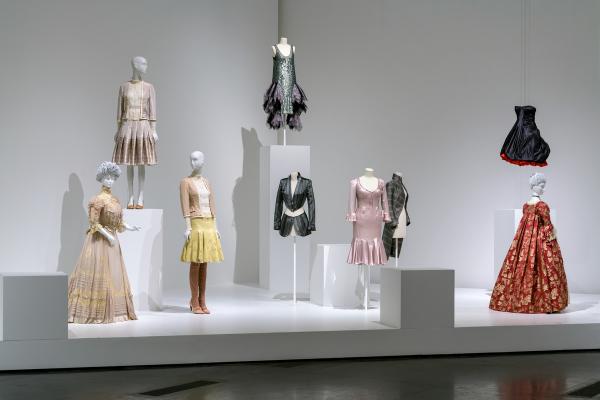What comes to mind when we think of the word packing? Folding? Rolling? Stuffing clothes into a suitcase? Packing may not seem like the most glamorous activity, but for a touring museum exhibition it is the secret ingredient that ensures artwork can safely travel the world. This type of packing requires much more forethought and expertise, especially when the artwork in question comes from the Costume and Textiles department.

LACMA’s exhibition Lee Alexander McQueen: Mind, Mythos, Muse, curated by Clarissa Esguerra and Michaela Hansen, contains 75 ensembles and garments, as well as several accessories and flat textiles. Since the museum’s entire collection of costume and textiles is housed offsite, the objects displayed in the exhibition had to travel to the museum on a truck. In order to protect them, the objects were meticulously packed according to our exacting touring exhibition standards. That means that, to safely transport the garments, shoes, accessories, and textiles, my colleagues Rachel Tu, Jenn Iacovelli, and I packed the objects the same way for their short journey to the museum as we would pack them to travel to the other side of the world. Packing for the McQueen exhibition began in late November, shortly after I joined the museum staff as a Jr. Collections Management Technician for Costume and Textiles. This undertaking was, therefore, one of my first big projects at LACMA and a great opportunity to expand upon the knowledge I gained in my masters program and acquire a new skill set by handling a world-class collection. I’ll explain how we carefully surveyed each ensemble and made thoughtful packing decisions based on the needs of each individual garment, as well as demonstrate the methods we used to achieve the necessary support and stabilization required to safely transport them.

Packing Ensembles
To begin packing the McQueen ensembles, there were a number of questions we had to take into consideration: how many objects would need to be kept together? How long or voluminous were the garments? Were any of the objects in poor condition or made of fragile materials? The answers to these questions helped us to determine what would be packed together and what size box to use for each ensemble. In permanent storage of LACMA’s Costume and Textiles collection, objects are typically stored with like objects. Shoes are stored with other shoes and garments are stored with other garments of a similar type, time period, artist, or place of origin. Objects made of non-woven materials, such as leather, fur, or plastic, are typically kept away from those made of materials such as cotton and silk due to the possibility that they will degrade and release fumes that could negatively affect the objects around them.
When packing for a touring exhibition, however, we take a very different approach. To create complete looks for the mannequins in the McQueen exhibition, the curators chose to create ensembles out of objects that were not originally intended to be worn together or were accessioned, or entered, into the collection at different times, and would, therefore, not typically be housed in the same box in storage. To make installing the exhibition as straightforward and smooth as possible, we packed all of the objects in each ensemble, which includes garments, shoes, and accessories, into one box (fig. 3 and 4). In some instances, certain shoes and accessories had to be packed separately in order to best protect the objects due to their material or simply because they didn’t fit (fig. 5). For the most part, though, we were able to bring all of the separate pieces of each ensemble together and consolidate them into one box.
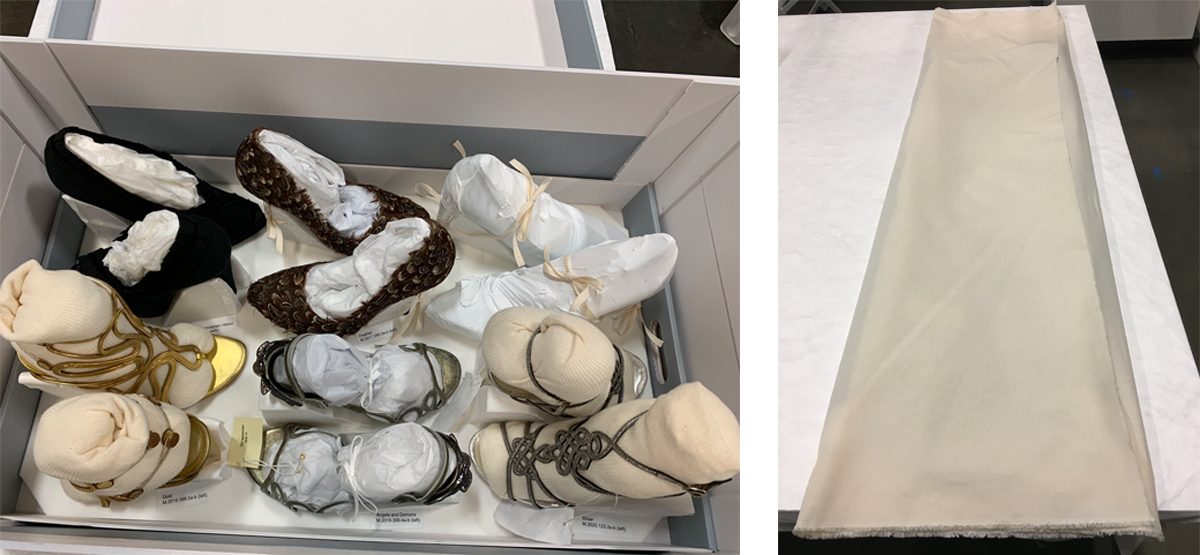
Strategic Use of Space
Each ensemble was placed on what we refer to as a “boat” (fig. 6), a piece of muslin fabric glued to an archival foam-core board, which provides a convenient and safe way to lift an ensemble out of the box without handling the objects more than necessary. The more objects are handled, the greater the risk that they might become damaged. The length of muslin wrapped around an ensemble, as well as the fabric’s tooth, or texture, also helps to keep the objects in place. Although we generally tried to pack the ensembles visually from head to toe on their boats, it sometimes made more sense in terms of strategically using the space to switch things around. In one case, for example, the shoes were placed in the empty space above the shoulders of the jacket in order to fit them in the box with their coordinating garments (fig. 7). In another, the shoes were placed below the proper left sleeve, the only available space in the box due to the skirt’s length and volume (fig. 8).

Other techniques we use to utilize the space in a box in an efficient and strategic manner and safely pack multiple objects together are nesting, layering, and using “overpasses.” Nesting involves placing one object inside of another. We often nest a pair of pants or a skirt into a jacket or structured blouse when packing for travel (fig. 9), which not only saves space in the box but also uses the bulk of the lower garments, in this case pants, to support the upper garments, the jacket. Layering involves putting one object on top of another, of course, with a layer of tissue in between: as long as they are properly supported, flatter garments can be layered under more structured garments without harm to the objects (fig. 10). We also often layer smaller objects such as gloves, lace accessories, and belts under their coordinating garments. When packed garments don’t take up the entire height of a box, we use what we call “overpasses” in order to fit two boats in one box. An overpass is a bridge made of archival foam-core or blue board folded at both ends and placed in a box over a packed ensemble (fig. 11). With an overpass placed at each end and in the middle of the box, a second boat can be placed on top. This allows us to keep the weight of the second boat off of the first, while making use of the full height of the box.
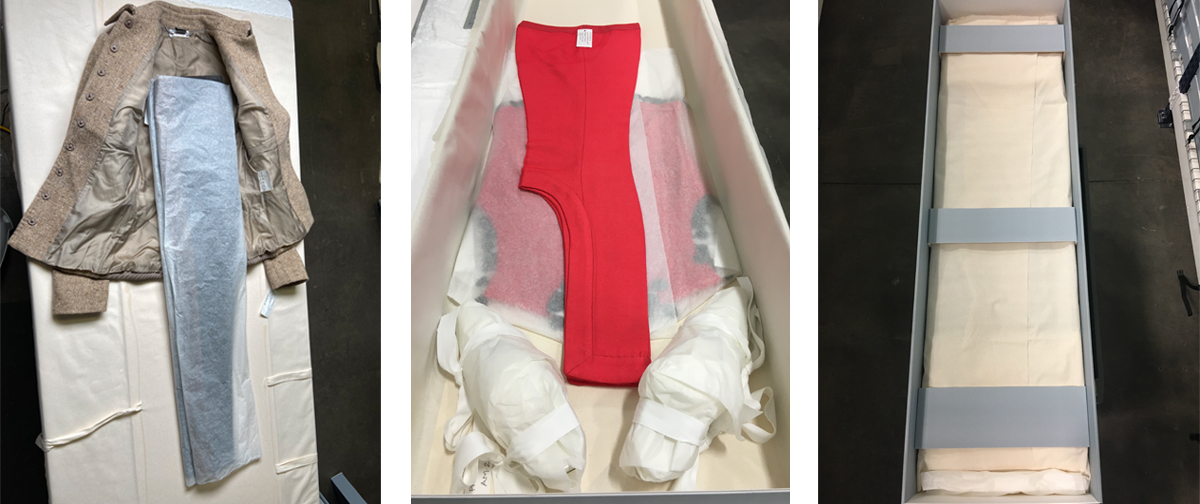
Stabilization of Objects
Constant vibration, sudden lurching movements, and potential box tipping are all concerns when objects are being brought from one location to another. To prevent these incidents from causing damage, there are three concepts I found most important to think about when packing the McQueen objects for travel: the need to support, control, and immobilize the objects.
Support
Garments need to be properly supported to remain in the best possible condition. We use unbuffered acid-free tissue paper to support objects in our permanent storage as well as those we pack to travel. Tissue is soft enough to be easily molded into various shapes, but also maintains enough structure to create a proper foundation for a garment. Garments are given more tissue support when being packed for a traveling exhibition than for storage because of the possibility of excessive movement. Without enough support, certain elements like structured shoulders, collars, boned bodices, and busts could begin to collapse over time and from constant motion, causing fabric to become wrinkled, crushed, and misshapen. We therefore use tissue gathered into fans and twisted into “cinnamon roll” and “sausage” shapes to add a supportive base to the vulnerable parts of the garments we pack (fig. 12). To create a cinnamon roll, tissue is gathered into a fan, twisted around the hand, and has its end tucked into the middle, creating a 3D circular support. A tissue sausage is created by gathering tissue into a fan about three quarters of the way, then rolling the remaining smooth tissue around the gathered tissue and tucking in the ends.
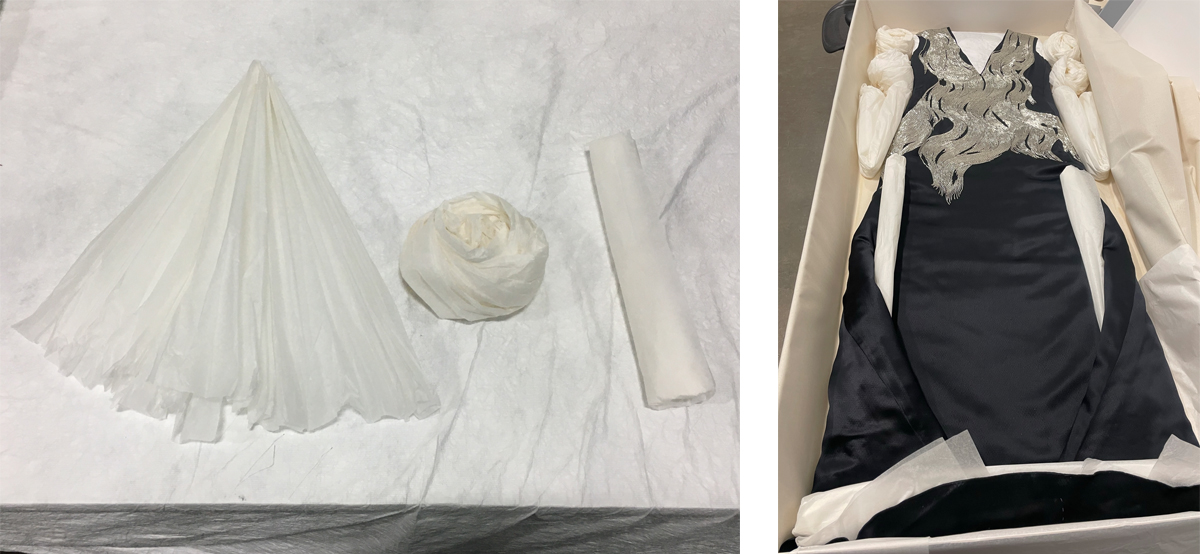
It is also important to support and soften the folds in garments so that they do not create hard-to-remove creases. To prevent this, we used tissue in the sides and sleeves of the McQueen garments, where they might crease from lying flat, as well as in other folds inherent to their construction or created out of necessity during packing. To fit wide skirts into boxes, for example, we often had to fold over the extra width on the sides (fig. 13) or neatly arrange them by folding the excess fabric back and forth (fig. 14). To fit sleeves safely in a box, we crossed them over the body of the garment. In all of these cases, tissue fans and sausages ensured that the added folds did not create creases in the garments.
One example that clearly demonstrates the need for structural support is the suit jacket in figure 15, from McQueen's Fall/Winter 2003–04 Scanners collection. The round collar looks flattened and the body of the jacket appears sunken in with no tissue support. If left alone, the sagging could cause the fabric to permanently stretch, altering the appearance of the garment. To properly support the jacket (fig. 16), I gathered tissue into fans and added them to the sleeves to soften their sides. I also added fans to the body of the jacket to support the bust and the zipper, as well as add softness to the sides of the jacket. Because this is a tailored garment, and therefore more shaped, a tissue sausage was put through the shoulders to help them maintain their structure and a tissue cinnamon roll was added below the sausage to keep it in place. I used a smaller sausage below the cinnamon roll to fill in the remaining empty space. I also added a folded strip of tissue inside the high collar to help maintain its shape. Figure 17 shows the end result, the jacket fully supported with tissue.
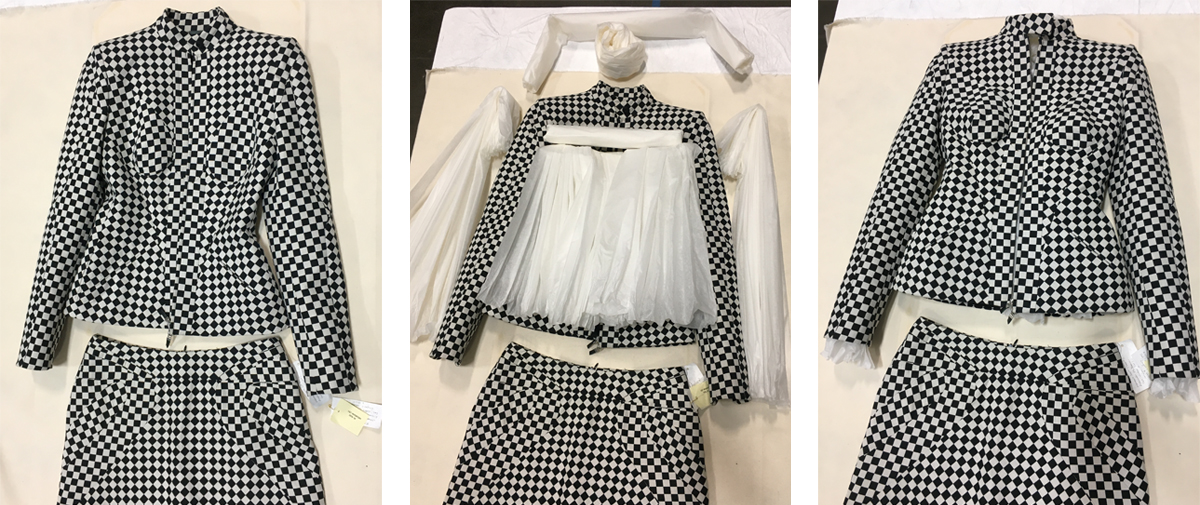
In order to fit the jacket on the boat, a small sausage was placed under each arm and the sleeves were brought in towards the center. The matching checkerboard skirt also required tissue support to maintain its shape (fig. 18). The majority of the skirt’s fullness is in the back, so I laid the garment on its front in order to prevent crushing the excess fabric. I neatly arranged the fullness and added long sausages along the sides of the skirt to prevent creasing and shorter sausages to each ripple in the fabric to prevent the skirt’s fullness from deflating (fig. 19).
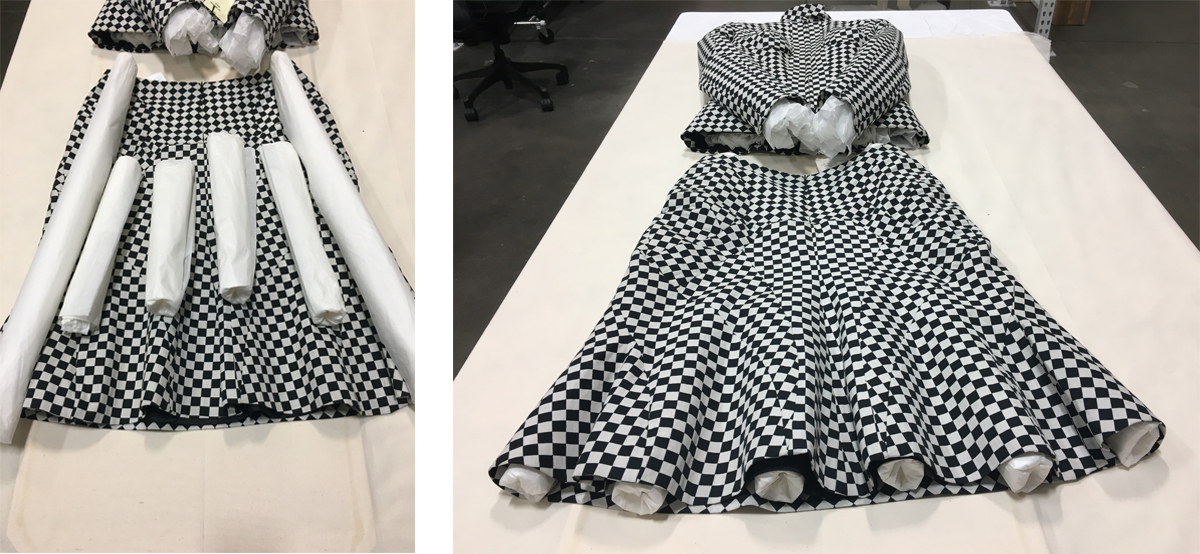
Padding out a garment with tissue helps to alleviate stress on the fabric and seams. Too much tissue, however, can require unnecessary extra handling of an object and create undue stress. The goal is not to stuff out an object as if it was being worn by a person, but to give it enough support to maintain its proper shape. It is important to strike the right balance of just enough support, as excessive support may actually be causing more harm than help. Flatter, non-structured garments made of materials that don’t easily wrinkle, such as the dress shown in figure 20, were left flat because the introduction of a sausage in their sides would have added too much bulk and could have caused stress on the material.
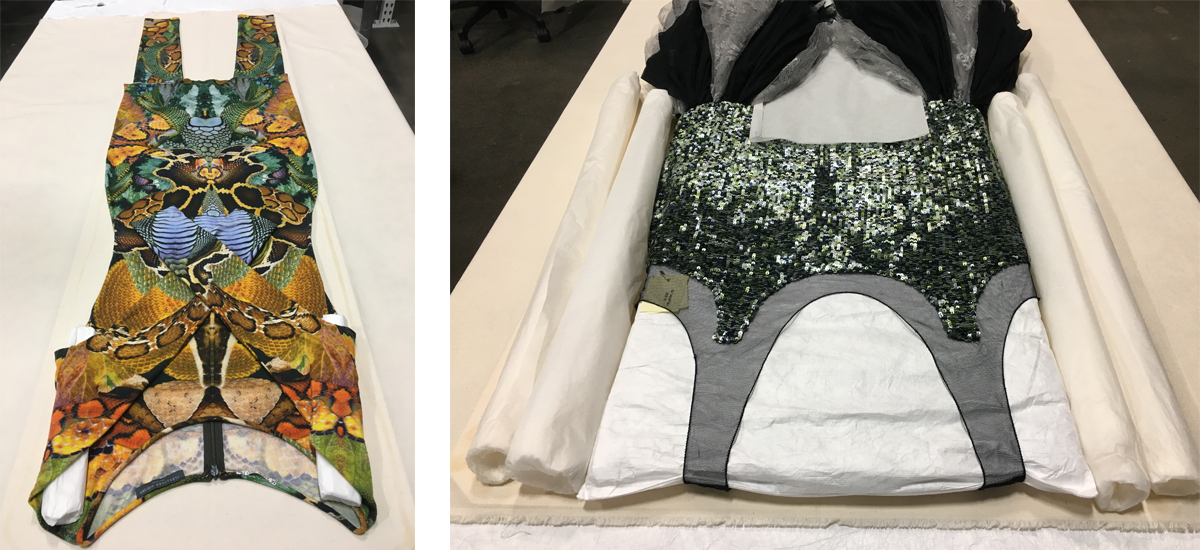
While we used mostly tissue to support the McQueen garments, we also utilized archival grade, resin-free polyester batting, tyvek, and muslin in the form of custom-made pillows. Our “beaded dress supports” are essentially long pillows made of batting covered in tyvek pillowcases. They are used to take the weight of the front of a heavy garment off of the back and evenly distribute it to prevent the back from getting crushed. We inserted these supports into heavier McQueen dresses covered in beads and sequins (fig. 21) to provide them with a sturdier foundation than tissue could supply. I also created the custom bolster pillow seen in figure 22 to provide support to the structured panels in the wide hips of the dress in figure 23.
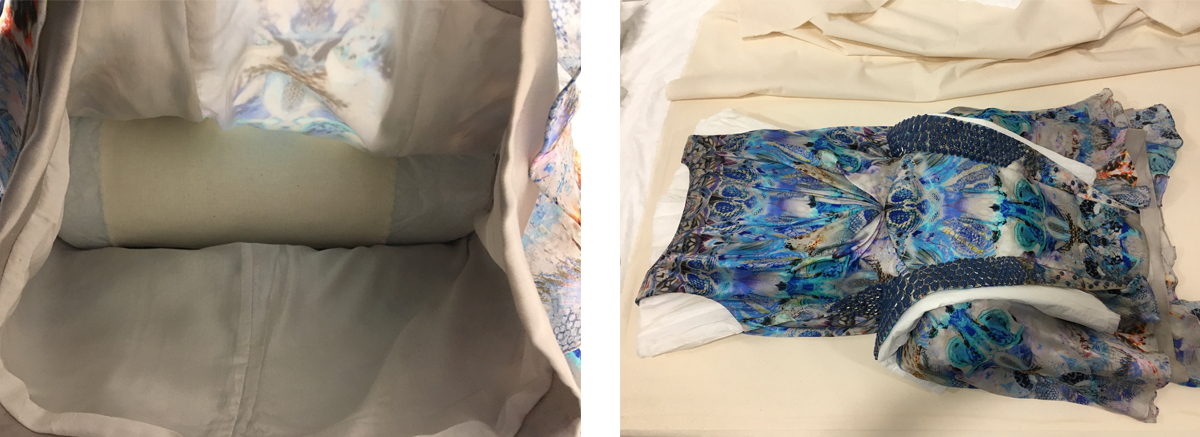
Control
Maintaining control is crucial when packing a garment so that it lies exactly how you intend it to in its box. Many of McQueen’s designs feature pleats, full skirts, drapery (often in unexpected places), and suspended embellishments. These design elements had to be appropriately contained in order for the garments to be packed in an organized and deliberate manner and so that they didn’t become damaged or misshapen while in transit. As with supports, this control was also performed using tissue. We often used what we refer to as “bandage,” which, in this case, is a piece of tissue tucked in on either side of a garment. This simple technique helped us to anchor otherwise unruly fabric, keep sleeves in their intended place, and secure all of the other tissue used to support the garments (fig. 24). The checkerboard suit, for example, was packed using two bandages. First, two long sausages were placed at the edges of the boat and the extra width of the skirt was folded over so that the garment would fit on the boat. A bandage was then tucked in on either side of the skirt to hold all of the sausages in place and keep the skirt contained. A second bandage was tucked on either side of the jacket to keep the sleeves angled inwards (fig. 25).
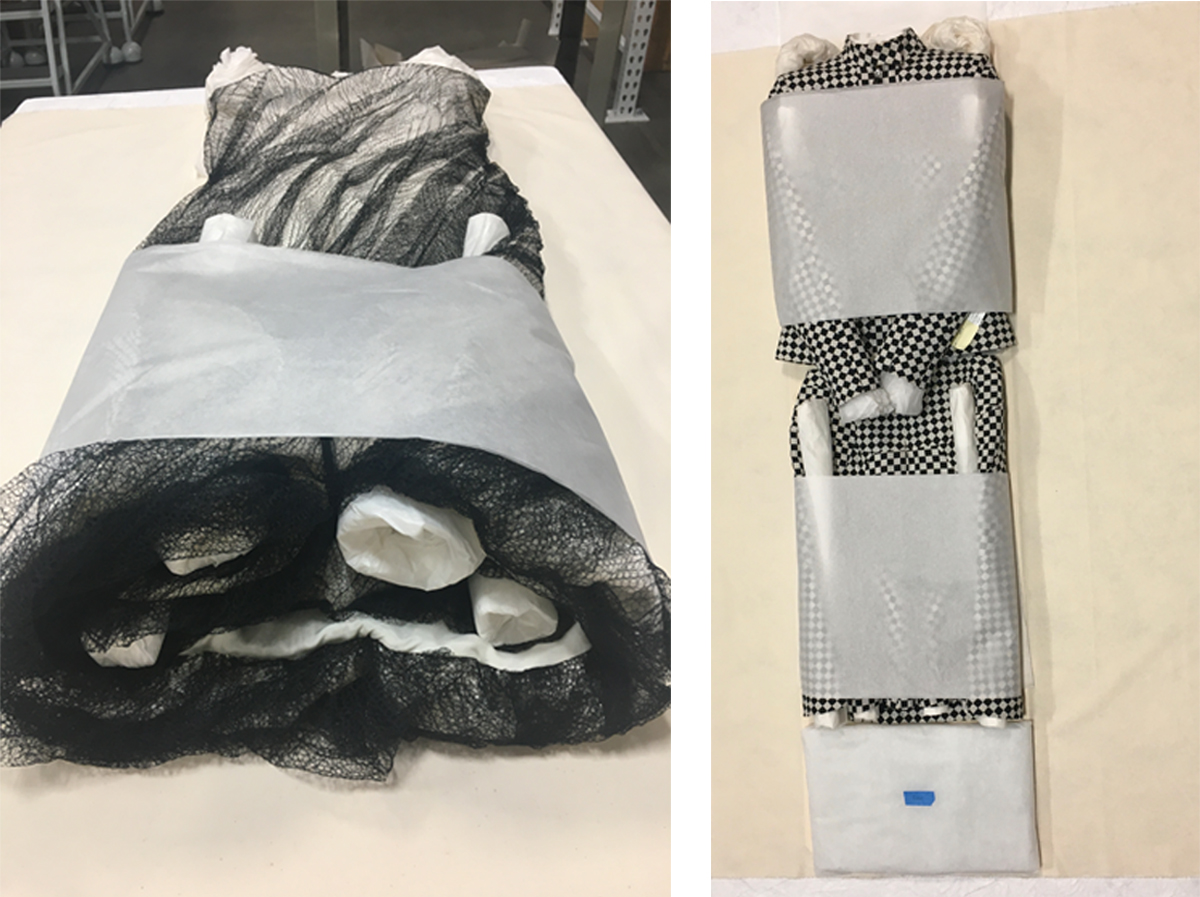
In certain instances, tissue was also used to maintain control by adding rigidity. Garments made of more slippery fabrics like satin or crepe would slide around in their boxes without the addition of something to stiffen them. For dresses made of silk crepe and synthetic knits, flat tissue inserted through the body helped them to maintain their shape and make them less vulnerable to movement (fig. 26). Button down shirts and limp sleeves also required the rigidity afforded by flat pieces of tissue folded to their shape, which allowed them to be properly maneuvered to the best position.
Immobilization
Immobilizing the objects being transported also played an important role in their safety. To prevent heavy accessories like shoes and belts from shifting in the boxes during their journey, they were wrapped in a protective layer of tissue and tied down with twill tape anchored through the boat (fig. 27 and 28). Once we decided where the accessories best fit in relation to the rest of the ensemble, we determined exactly where the ties needed to be, removed the museum objects from the vicinity, carefully cut slits into the boat with a box cutter, and pushed the twill tape through the boat with a metal spatula. Tying the objects down permitted us to properly immobilize them, ensuring that they wouldn’t become damaged or damage the other items in the box while it was in motion.
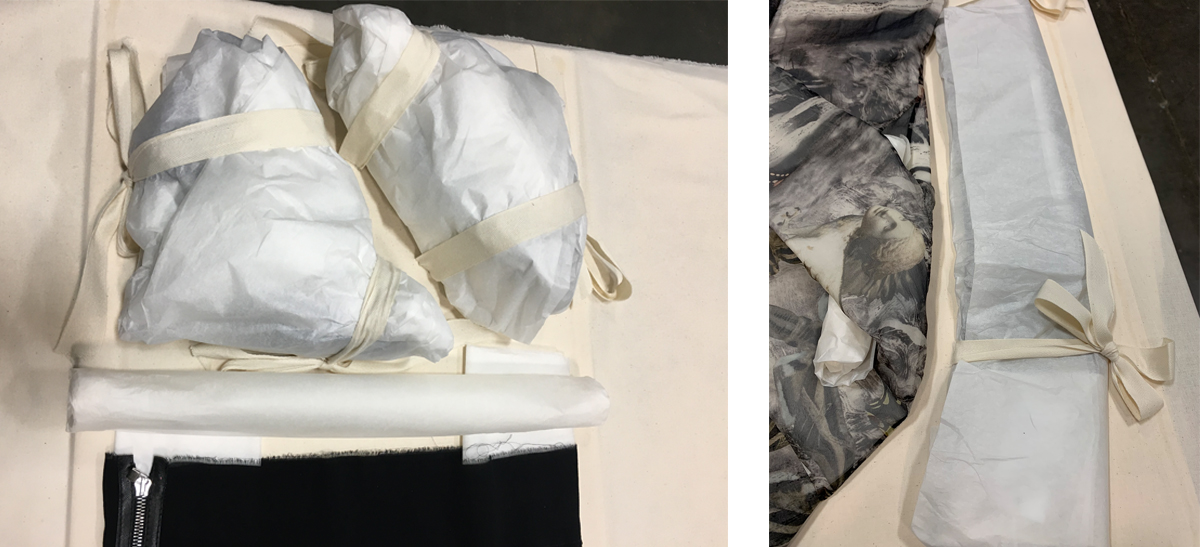
It is also important to ensure that the garments themselves don’t shift during transport, so all empty space in a box must be filled. Without anything above the shoulders of a jacket, for example, it could potentially slide upwards and the collar could be crushed. Without something below a dress, the skirt could become wrinkled and misshapen were the dress to slide to the bottom of the box. We therefore filled the voids in a box with tissue in cinnamon roll and sausage shapes and with tissue packages of polyester batting to keep the objects in place. To revisit the McQueen checkerboard suit mentioned above, I packed the remaining space in the box with a tissue wrapped batting package labeled “filler,” so as not to confuse it with a wrapped garment or accessory (fig. 29). I also placed a cinnamon roll above each shoulder to keep the jacket in place (fig. 30) and with that, the packing was complete.

Packing the garments for Lee Alexander McQueen: Mind, Mythos, Muse presented a number of unique challenges. McQueen’s designs are anything but standard. His artful use of drapery and embellishment, as well as the unconventional construction of his garments, made packing each ensemble a new experience. Properly supporting, controlling, and immobilizing a garment aids not only its longevity but also shows our respect for the objects that we work with. As collection management professionals of costume and textiles at LACMA, we are charged with the care of the artwork in our collection. We help to preserve the work of renowned couturiers and nameless modistes alike, so that their creations will continue to tell their stories of the past in the future. Taking the time to ensure that these garments, shoes, accessories, and textiles were properly supported and secure demonstrates to whoever next opens their boxes, whether that be staff at LACMA or another museum, how much we admire and appreciate these objects. After its run at LACMA, the exhibition will be packed up once again to travel to several other institutions around the world. Thanks to our careful and meticulous packing methods, McQueen’s masterpieces will be able to amaze visitors all across the globe.
The exhibition Lee Alexander McQueen: Mind, Mythos, Muse is on view in the Resnick Pavilion through October 9, 2022.



